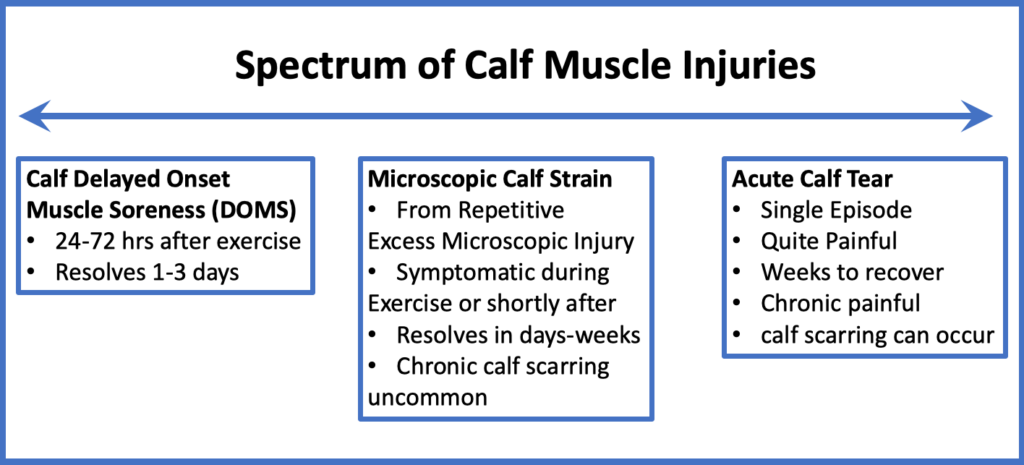Delayed Onset Muscle Soreness (DOMS) affecting the Calf Muscle
Summary
Discomfort can occur in the calf muscle, in a delayed fashion after a strenuous workout due to delayed onset muscle soreness (DOMS). The onset of muscle soreness in the calf can vary, but is usually 12-72 hours after the activity. Symptoms occur as part of the body’s intense healing response to the microscopic muscle tissue damage that occurred during the inciting activity. Symptoms will usually resolve within 1-3 days. Massage, use of a foam roller, and gentle stretching can be helpful in the recovery period. Symptoms that persist are likely due to other causes including potentially chronic calf muscle scarring or subclinical calf tearing.
What Causes Delayed Onset Muscle Soreness of the Calf Muscle?
It is common to have discomfort in the calf muscles that develops 12 to 72 hours after an episode of intense exercise or activity that puts a greater than normal repetitive load on the lower extremity. This is called delayed onset muscle soreness, or DOMS. This delay occurs because the exercise creates microscopic injury to the muscle. The healing of these microscopic muscle injuries is how a muscle gets stronger. However, the inflammatory component related to the muscle healing repair process takes a while to set up and it is often only at this point that discomfort in the calf is experienced. Delayed onset muscle soreness (DOMS) is different than an acute pronounced calf muscle tear during exercise. A calf tear occurs via a sudden tearing of the muscle fibers leading to immediate pain, and often eventual bruising around the area.
Calf pain may also occur during activity, or shortly thereafter, if repetitive forces through the calf muscles are so great that the calf muscle fibers are notably injured. This type of calf injury is on a spectrum in between delayed onset muscle soreness and an acute tearing of the cast muscle (Figure 1). Unlike DOMS it can produce permanent scarring of the calf muscle similar to a calf tear. However, unlike an acute calf tear it does not occur from a single acute episode of calf muscle tearing, but rather from repetitive excessive loading of the calf muscle.

Clinical Examination Findings in Calf Muscle DOMS
Individuals with painful DOMS affecting their calf muscles will have localized calf discomfort 12–72 hours after significant exercise. The muscles themselves may be stiffer and harder than normal. Patients with DOMS affecting the calf muscle may walk with a slight limp
Treatment of Calf Muscle DOMS
Symptomatic calf delayed onset muscle soreness (DOMS) will resolve with time and backing off intense activities. In the short-term local massage, the use of a foam roller, and graduated calf stretching can be helpful. Inflammatory medication can help with symptoms if pain is pronounced, although they are generally not needed.
Patients with DOMS of the calf muscle will generally resolve their symptoms without any residual symptoms in a few days. However, if the calf symptoms are actually from tearing of the calf muscle with resulting scarring, the recovery can be longer, and in some individuals the scarring of the calf muscle will potentially create chronic symptoms.
Edited January 17, 2024